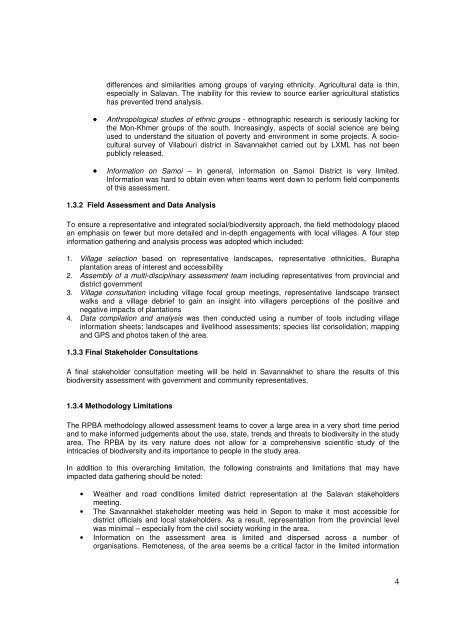Part 1 – A Rapid Participatory Biodiversity Assessment - IUCN
Part 1 – A Rapid Participatory Biodiversity Assessment - IUCN
Part 1 – A Rapid Participatory Biodiversity Assessment - IUCN
Create successful ePaper yourself
Turn your PDF publications into a flip-book with our unique Google optimized e-Paper software.
differences and similarities among groups of varying ethnicity. Agricultural data is thin,<br />
especially in Salavan. The inability for this review to source earlier agricultural statistics<br />
has prevented trend analysis.<br />
• Anthropological studies of ethnic groups - ethnographic research is seriously lacking for<br />
the Mon-Khmer groups of the south. Increasingly, aspects of social science are being<br />
used to understand the situation of poverty and environment in some projects. A sociocultural<br />
survey of Vilabouri district in Savannakhet carried out by LXML has not been<br />
publicly released.<br />
• Information on Samoi <strong>–</strong> in general, information on Samoi District is very limited.<br />
Information was hard to obtain even when teams went down to perform field components<br />
of this assessment.<br />
1.3.2 Field <strong>Assessment</strong> and Data Analysis<br />
To ensure a representative and integrated social/biodiversity approach, the field methodology placed<br />
an emphasis on fewer but more detailed and in-depth engagements with local villages. A four step<br />
information gathering and analysis process was adopted which included:<br />
1. Village selection based on representative landscapes, representative ethnicities, Burapha<br />
plantation areas of interest and accessibility<br />
2. Assembly of a multi-disciplinary assessment team including representatives from provincial and<br />
district government<br />
3. Village consultation including village focal group meetings, representative landscape transect<br />
walks and a village debrief to gain an insight into villagers perceptions of the positive and<br />
negative impacts of plantations<br />
4. Data compilation and analysis was then conducted using a number of tools including village<br />
information sheets; landscapes and livelihood assessments; species list consolidation; mapping<br />
and GPS and photos taken of the area.<br />
1.3.3 Final Stakeholder Consultations<br />
A final stakeholder consultation meeting will be held in Savannakhet to share the results of this<br />
biodiversity assessment with government and community representatives.<br />
1.3.4 Methodology Limitations<br />
The RPBA methodology allowed assessment teams to cover a large area in a very short time period<br />
and to make informed judgements about the use, state, trends and threats to biodiversity in the study<br />
area. The RPBA by its very nature does not allow for a comprehensive scientific study of the<br />
intricacies of biodiversity and its importance to people in the study area.<br />
In addition to this overarching limitation, the following constraints and limitations that may have<br />
impacted data gathering should be noted:<br />
• Weather and road conditions limited district representation at the Salavan stakeholders<br />
meeting.<br />
• The Savannakhet stakeholder meeting was held in Sepon to make it most accessible for<br />
district officials and local stakeholders. As a result, representation from the provincial level<br />
was minimal <strong>–</strong> especially from the civil society working in the area.<br />
• Information on the assessment area is limited and dispersed across a number of<br />
organisations. Remoteness, of the area seems be a critical factor in the limited information<br />
4

















